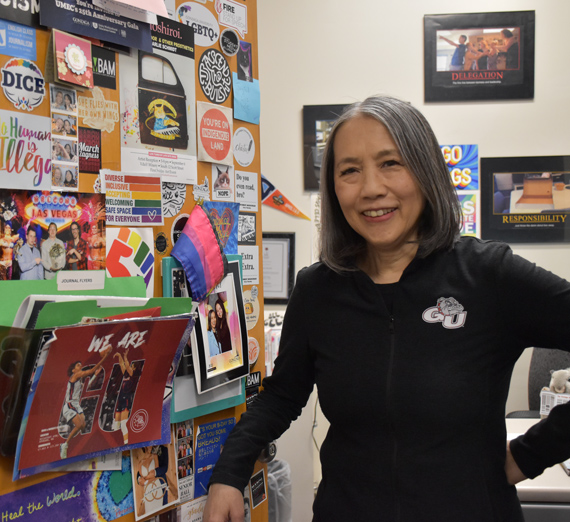Joanne Shiosaki: Thirty Years With a Corner View

It is a pleasure for a storyteller to interview someone who understands the craft of storytelling. The detail in their anecdotes is amplified, much to the joy of the notetaker.
Joanne Shiosaki arrived in 1994 to oversee student media, and while the students have become intricately more sophisticated in their work over her 30 years in the same job, the expectations have not changed: Give students an opportunity to expand their marketable skills by producing quality, uncensored publications, all student produced, and cover their expenses.
“Back in the day” all budgeting was done on paper and it took the University a month to reconcile the ledger and get a report back to each office.
She can recite issue after issue she and her student editors have faced over her tenure and their mostly positive resolution.
She was blessed with excellent faculty advisers. Former Journalism professor and adviser Tom Miller is one of those, and he reinforced with the student writers and editors on The Bulletin that “You can’t make mistakes with sensitive issues and information that could damage people’s reputations if the information is not correct,” Shiosaki says.
Shiosaki recalls one column about BYU joining the West Coast Conference that made jest of the Mormon faith.
“We received a lot of calls and emails from folks who were offended by it,” Shiosaki says.
“We were called to the president’s office. To President McCulloh’s credit he didn’t punish the students but used it as an educational moment. He shared with our student editor a four-inch binder with letters and emails he had received in response to the column. It helped us realize that what we say in The Bulletin has a far reach.”
Paying the Piper
Producing publications requires paying for paper, production and student salaries.
When Shiosaki arrived in 1994, annual ad sales amounted to $20,000. This year students are on record pace to reach $190,000 in ad sales, an important number when publication costs continue to rise. In addition to paper and press costs, Shiosaki’s payroll has grown to include 80 student salaries.
She does her work from a tiny eight-by-eight- foot office inside a meeting room on the northeast corner of fourth floor in College Hall. She has always enjoyed her autonomy in that tiny, windowless office with brightly decorated posters and pinups of events, festivities and causes of every color and shape.
“I joke that one of the secrets to my longevity here is that my supervisors always left me alonetodomywork...noonewantedto climb four flights of stairs to see me,” Shiosaki cracks.
Emphasis on Diversity
The affable behind-the-scenes mentor to hundreds of students treasures the University’s efforts to make Gonzaga a welcoming place for people of diverse backgrounds. She has seen significant changes since 2012.
“It was part of our Strategic Plan introduced in 2012. Then, one person, Bob Bartlett, ran the Unity House across from the COG. Now UMEC has a spacious spot in the Hemmingson Center, at least five employees and a dean of DEI in Joan Iva Fawcett. The Office of Diversity, Equity and Inclusion had one person running the shop in Raymond Reyes. Now the Office of Inclusive Excellence has five people with two more expected by fall,” she says.
“And we would not see the changes we’ve experienced in the last dozen years if not for the voices of our students and allies who have spoken out for social justice. I am proud to be
part of an organization that puts people first and lives its mission.”
As part of her work in Student Affairs, Shiosaki has administered the Intercultural Development Index to colleagues and students and has provided group presentations on Intercultural Competency Assessment.
She is particularly grateful for her Student Affairs VPs: Sue Weitz, Judi Biggs-Garbuio and Kent Porterfield. “People here have always had the mission and the welfare of our students at the forefront.”
Shiosaki will retire in spring 2025, leaving more time to spend with her video artist husband, Charlie Schmidt, creator of Keyboard Cat and Dancing Nose, and daughter Sydney (’20), an aerospace engineer for Blue Origin in Seattle.
